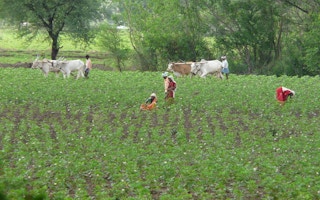Two Indian states are suffering the first major pest infestation since the country adopted genetically modified cotton in 2002, raising concerns over the vulnerability of the lab-grown seeds that yield nearly all of the cotton in the world’s top producer.
Damage from the whitefly attack on the Bt cotton variety in the states of Punjab and Haryana is likely to be extensive and has even been blamed for farmer suicides, according to local officials and experts.
India’s overall crop losses are expected to be light, because the states are not major producing centres, but the pest attack is inflaming debate over the usage of GM crops.
Bt cotton was tweaked by scientists at Monsanto to produce its own insecticide to kill pests like bollworms. But two years of drought have encouraged the spread of whitefly against which the strain has no resistance. The winged pest damages the leaves of the cotton plant by sucking out fluid.
“Bt technology is effective only against specific types of bollworms that are known to cause maximum yield loss and economic damage to the cotton crop,” said a spokesman for Mahyco Monsanto Biotech (India) Pvt. Ltd.
The joint venture between India’s Mahyco and a local unit of Monsanto has sub-licensed production of its Bt cotton strains - first approved for sale in India in 2002 - to 28 seed companies.
“Currently there are no approved agriculture biotechnology solutions to counter the infestation of whiteflies. The recommended solution for farmers is spraying of approved pesticides.”
The Bt seeds cost more than older cotton strains and must be bought new each year by farmers. The companies that market the GM cotton say growers end up better off because they get higher yields and save money on pesticides, but some farmer groups are concerned about growing dependency on the new varieties.
The farmers’ union allied to Prime Minister Narendra Modi’s ruling party is stepping up its opposition: It wants Bt cotton banned and is trying to block the introduction of crops like GM mustard - an oilseed - now in development.
“
We have been telling the government to conduct tests on all GM seeds before they are sold in the market.
Mohini Mohan Mishra, general secretary of Bharatiya Kisan Sangh
“We have been telling the government to conduct tests on all GM seeds before they are sold in the market,” said Mohini Mohan Mishra, general secretary of Bharatiya Kisan Sangh, or Indian Farmers Union.
A team of scientists and government officials had visited Punjab and Haryana to help contain the pest attack and there had been no reports of outbreaks in other parts of the country, said an agriculture ministry official.
Dozen suicides
The Punjab government has already earmarked 6.4 billion rupees ($100 million) to compensate for crop damage and an official in Haryana’s farm ministry said the state was also considering compensation.
“There are reports of the pest attack in some areas of Punjab and Haryana, where about a dozen farmers have reportedly committed suicide,” said a Punjabi official who spoke on condition of anonymity.
The infestation is unlikely to have a significant impact on national output, but experts see serious local damage.
“If the number of insects is eight to 10 per leaf, the attack is said to have crossed the ETL - or economic threshold level,” said Dalip Monga, principal scientist at India’s Central Institute of Cotton Research.
In Haryana’s Sirsa district, said Monga, “we have observed 15 to 20 insects per leaf at most places and even up to 30 to 40 insects per leaf.”
National output could drop by 1.5 per cent this year from the 37.7 million bales (1 bale = 170 kg) in the year to September, said Dhiren Sheth, head of the Cotton Association of India.
India grows cotton on 11-12 million hectares and nearly 95 percent is GM cotton.
In Punjab, cotton covers about 450,000 hectares, with about 40 percent prone to the pest attack this year, said the first official.
“We sprayed different kinds of pesticides but none of them worked,” Ashok Dhaka, a Punjab cotton farmer, said by telephone.










